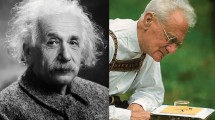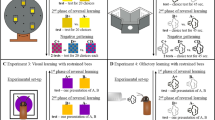Abstract
The life style of honey bees requires them to learn a variety of specific things in order to navigate and forage. The need for learning is sufficiently predictable with regard to the behavioral contexts and useful cues that it is highly structured and relatively easily studied. Although each cue seems to be learned independently, the set of cues memorized in each context appears to be stored as a unit. The exact nature of the storage system for flower shape, landmarks near the food, and navigational landmarks, as well as certain navigational parameters, is not yet perfectly clear. The nature of these ambiguities is explored. The possibility that some form of a synaptic selection strategy might underlie bee learning is also explored in a preliminary way.
Access this chapter
Tax calculation will be finalised at checkout
Purchases are for personal use only
Preview
Unable to display preview. Download preview PDF.
Similar content being viewed by others
References
Anderson, A.M. 1972. The ability of honey bees to generalize visual stimuli. In Information Processing in the Visual System of Arthropods, ed. R. Wehner, pp. 207–212. Berlin: Springer-Verlag.
Anderson, A.M. 1977. A model for landmark learning in the honey bee. J. Comp. Physiol. 114: 335–355.
Anderson, A.M. 1977. Parameters determining the attractiveness of stripe patterns in the honey bee. Anim. Behay. 25: 80–87.
Anderson, A.M. 1977. Shape perception in the honey bee. Anim. Behay. 25: 67–69.
Anderson, A.M. 1977. The influence of pointed regions on the shape preference of honey bees. Anim. Behay. 25: 88–94.
Anderson, A.M. 1979. Visual scanning in the honey bee. J. Comp. Physiol. 130: 173–182.
Anderson, A.M. 1979. Visual scanning in the honey bee. J. Comp. Physiol. 130: 173–182.
Baerends, G.P. 1941. Fortpflanzungsverhalten und Orientierung der Gradwespe. Tijdschrift Entomol. 84: 68–275.
Bitterman, M.E., and Couvillon, P.A. 1982. Compound conditioning in honey bees. J. Comp. Physiol. Psychol. 96: 192–199.
Bogdany, F.J. 1978. Linking of learning orientation. Behay. Ecol. Sociobiol. 3: 323–336
Booker, R., and Quinn, W.G. 1981. Conditioning of leg position in normal and mutant Drosophila. Proc. Natl. Acad. Sci. 78: 3940–3944.
Brines, M. 1978. Skylight polarization patterns as cues for honey bee orientation: physical measurements and behavioral experiments. Ph. D. Thesis, Rockefeller University, New York.
Brines, M.L., and Gould, J.L. 1979. Bees have rules. Science 206: 571–573.
Brines, M.L., and Gould, J.L. 1982. Skylight polarization patterns and animal orientation. J. Exp. Biol. 96: 69–91.
Cartwright, B.A., and Collett, T.S. 1982. How honey bees use landmarks to guide their return to a food source. Nature 295: 560–564.
Cartwright, B.A., and Collett, T.S. 1983. Landmark learning in bees. J. Comp. Physiol. 151: 521–543.
Changeux, J.-P., and Danchin, A. 1976. Selective stabilization of developing synapses as a mechanism for the specification of neuronal networks. Nature 264: 705–712.
Collett, T.S., and Cartwright, B.A. 1983. Eidetic images in insects: their role in navigation. Trends Neurosci. 5: 101–105.
Collett, T.S., and Land, M.F. 1975. Visual spatial memory in a hoverfly. J. Comp. Physiol. 100: 59–84.
Couvillon, P.A., and Bitterman, M.E. 1980. Some phenomena of associative learning in honey bees. J. Comp. Physiol. Psychol. 94: 878–885.
Cruse, H. 1972. A qualitative model for pattern discrimination in the honey bee. In Information Processing in the Visual System of Arthropods, ed. R. Wehner, pp. 201–206. Berlin: Springer-Verlag.
Daumer, K. 1958. Blumenfarben, wie sie die Bienen sehen. Z. vgl. Physiol. 41: 49–110.
Dyer, F.C., and Gould, J.L. 1981. Honey bee orientation: a backup system for cloudy days. Science 214: 1041–1042.
Dyer, F.C., and Gould J.L. 1983. Honey bee navigation. Am. Sci. 71: 587–597.
Edelman, G., and Mountcastle, V. 1978. The Mindful Brain Cortical Organization and the Group-Selective Theory of Higher Brain Function. Cambridge, MA: MIT Press.
Erber, J. 1972. The time-dependent sorting of optical information in the honey bee. In Information Processing in the Visual System of Arthropods, ed. R. Wehner, pp. 309–314. Berlin: Springer-Verlag.
Erber, J. 1975. The dynamics of learning in the honey bee. I. The time dependence of the choice reaction. J. Comp. Physiol. 99: 231–242.
Erber, J. 1976. Retrograde amnesia in honey bees. J. Comp. Physiol. Psychol. 90: 41–46.
Erber, J. 1981. Neural correlates of learning in the honey bee. Trends Neurosci. 4: 270–273.
Erber, J., and Schildberger, K. 1980. Conditioning of an antennal reflex to visual stimuli in bees. J. Comp. Physiol. 135: 217–225.
Frisch, K.V. 1967. The Dance Language and Orientation of Bees. Cambridge, MA: Harvard University Press.
Frisch, K.V., and Jander, R. 1957. Über den Schwanzeltanz der Bienen. Z. vgl. Physiol. 40: 239–263.
Frisch, K.V., and Lindauer, M. 1954. Himmel und Erde in Konkurrenz bei der Orientierung der Bienen. Naturwissenschaften 41: 245–253.
Gould, J.L. 1975. Honey bee communication: the dance-language controversy. Science 189: 685–692.
Gould, J.L. 1976. The dance-language controversy. Q. Rev. Biol. 51: 211–244.
Gould, J.L. 1980. Sun compensation by bees. Science 207: 545–547.
Gould, J.L. 1982. Ethology: The Mechanisms and Evolution of Behavior. New York: W.W. Norton.
Gould, J.L. 1984. Processing of sun-azimuth information by bees. Anim. Behay. 32, in press.
Gould, J.L.; Dyer, F.C.; and Towne, W.T. 1984. Recent progress in understanding the honey bee dance language. Fortsch. Zool., in press.
Gould, J.L., and Gould, C.G. 1982. The insect mind: physics or metaphysics? In Animal Mind-Human Mind, ed. D.R. Griffin, pp. 269–298. Dahlem Konferenzen. Berlin: Springer-Verlag.
Heran, H. 1958. Die Orientierung der Bienen im Flug. Ergebn. Biol. 20: 199–239.
Hertz, M. 1929a. Die Organisation des optischen Feldes bei der Biene, I. Z. vgl. Physiol. 8: 693–748.
Hertz, M. 1929b. Die Organisation des optischen Feldes bei der Biene, II. Z. vgl. Physiol. 11: 107–145.
Hertz, M. 1931. Die Organisation des optischen Feldes bei der Biene, III. Z. vgl. Physiol. 14: 629–674.
Hoefer, I., and Lindauer, M. 1975. Das Lernverhalten zweier Bienenrassen unter veränderten Orientierungsbedingungen. J. Comp. Physiol. 99: 119–138.
Hoefer, I., and Lindauer, M. 1976. Der Einfluß einer Vordressur auf das Lernverhalten der Honigbiene. J. Comp. Physiol. 109: 249–264.
Hoefer, I., and Lindauer, M. 1976. Der Schatten als Hilfsmarke bei der Orientierung der Honigbiene. J. Comp. Physiol. 112: 5–18.
Heinrich, B. 1979. Bumble Bee Economics. Cambridge, MA: Harvard University Press.
Holldobler, B. 198 0. Canopy orientation: a new kind of orientation in ants. Science 210: 86–88.
Horridge, G.A. 1962. Learning of leg position by headless insects. Nature 193: 697–698.
Janzen, D. 1974. The deflowering of Central America. Nat. Hist. 83 (4): 48–53.
Klosterhalfen, S.; Fischer, W.; and Bitterman, M.E. 1978. Modification of attention in honey bees. Science 201: 1241–1243.
Koltermann, R. 1973. Rassen-bzw. artspezifische Duftbewertung bei der Honigbiene und ökologische Adaption. J. Comp. Physiol. 85: 327–360.
Koltermann, R. 1974. Periodicity in the activity and learning performance of the honey bee. In Experimental Analysis of Insect Behavior, ed. L.B. Brown, pp. 218–227. Berlin: Springer-Verlag.
Kriston, I. 1973. Die Bewertung von Duft-und Farbsignalen als Orientierungshilfen an der Futterquelle durch Apis mellifera. J. Comp. Physiol. 84: 77–94.
Lauer, J., and Lindauer, M. 1971. Genetische fixierte Lerndisposition bei der Honigbiene. In Informationsaufnahme und Informationsverarbeitung im lebenden Organismus 1, pp. 1–87. Wiesbaden: Franz Steiner Verlag.
Lindauer, M. 1959. Angeborene und erlernte Komponenten in der Sonnenorientierung der Bienen. Z. vgl. Physiol. 42: 43–62.
Lindauer, M. 1963. Kompaßorientierung. Ergebn. Biol. 26: 158–181.
Lindauer, M. 1969. Lernen und Vergessen bei der Honigbiene. Proceedings of the VI Congress IUSSI, Bern.
Lindauer, M. 1976. Recent advances in the orientation and learning of honey bees. Proceedings of the XV International Congress on Entomology, pp. 450–460, Washington, D.C.
Maynard-Smith, J. 1976. Evolution and the theory of games. Am. Sci. 64: 41–45.
Menzel, R. 1979. Behavioral access to short-term memory in bees. Nature 281: 368–369.
Menzel, R. 1983. Neurobiology of learning and memory: the honey bee as a model system. Naturwissenschaften, in press.
Menzel, R., and Erber, J. 1972. Influence of the quantity of reward on the learning performance in honey bees. Behay. 41: 27–42.
Menzel, R., and Erber, J. 1978. Learning and memory in bees. Sci. Am. 239 (1): 102–110.
Menzel, R.; Erber, J.; and Masuhr, J. 1974. Learning and memory in the honey bee. In Experimental Analysis of Insect Behavior, ed. L.B. Browne, pp. 195–217. Berlin: Springer-Verlag.
Murphey, R.K., and Matsumoto, S.G. 1976. Experience modifies the plastic properties of identified neurons. Science 191: 564–566.
Nelson, M.C. 1971. Classical conditioning in the blowfly. J. Comp. Physiol. Psychol. 77: 353–368.
Opfinger, E. 1931. Über die Orientierung der Biene an der Futterquelle. Z. vgl. Physiol. 15: 431–487.
Prokopy, R.J.; Averill, A.L.; Cooley, S.S.; and Roitberg, C.A. 1982. Associative learning in egglaying site selection by apple maggot flies. Science 218: 76–77.
Quinn, W.G.; Harris, W.A.; and Benzer, S. 1975. Conditioned behavior in Drosophila melanogaster. Proc. Natl. Acad. Sci. 71: 708–712.
Ronacher, B. 1979a. Äquivalenz zwischen Groß- und Helligkeitsunterschieden im Rahmen der visuellen Wahrnehmung der Honigbiene. Biol. Cybernetics 32: 63–75.
Ronacher, B. 1979b. Beitrag einzelner Parameter zum wahrnehmungsgemäßen Unterschied von zusammengesetzten Reizen bei der Honigbiene. Biol. Cybernetics 32: 77–83.
Rosseil, S., and Wehner, R. 1982. The bee’s map of the e-vector pattern in the sky. Proc. Natl. Acad. Sci. 79: 4451–4455.
Schnetter, B. 1972. Experiments on pattern discrimination in honey bees. In Information Processing in the Visual System of Arthropods, ed. R. Wehner, pp. 195–200. Berlin: Springer-Verlag.
Templeton, B.L.; Bonini, N.; Dawson, D.R.; and Quinn, W.G. 1983. Reward learning in normal and mutant Drosophila. Proc. Natl. Acad. Sci. 80: 1482–1486.
Tinbergen, N., and Kruyt, W. 1938. Ueber die Orientierung des Bienenwolfes III. Die Bevorzugung bestimmter Wegmarken. Z. vgl. Physiol. 25: 292–334.
Van Beusekom, G. 1948. Some experiments on the optical orientation in Philanthus triangulum. Behay. 1: 195–225.
Wehner, R. 1972. Pattern modulation and pattern detection in the visual system of hymenoptera. In Information Processing in the Visual System of Arthropods, ed. R. Wehner, pp. 183–194. Berlin: Springer-Verlag.
Wehner, R. 1981. Spatial vision in arthropods. In Handbook of Sensory Physiology, ed. H. Autrum, pp. 287–616. Berlin: Springer-Verlag.
Author information
Authors and Affiliations
Editor information
Rights and permissions
Copyright information
© 1984 Berlin, Heildelberg, New York, Tokyo: Springer-Verlag
About this paper
Cite this paper
Gould, J.L. (1984). Natural History of Honey Bee Learning. In: Marler, P., Terrace, H.S. (eds) The Biology of Learning. Dahlem Workshop Reports, vol 29. Springer, Berlin, Heidelberg. https://doi.org/10.1007/978-3-642-70094-1_8
Download citation
DOI: https://doi.org/10.1007/978-3-642-70094-1_8
Publisher Name: Springer, Berlin, Heidelberg
Print ISBN: 978-3-642-70096-5
Online ISBN: 978-3-642-70094-1
eBook Packages: Springer Book Archive




